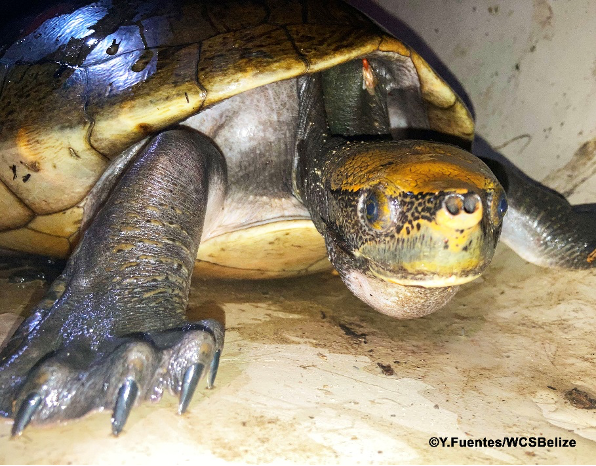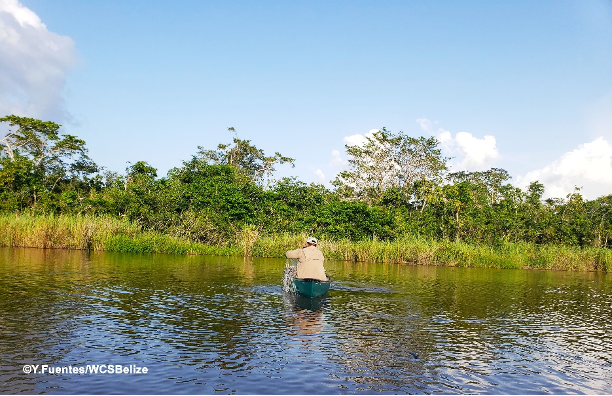BY D. ARZU - WILDLIFE CONSERVATION SOCIETY
“There was a little turtle. He lived in a box. He swam in a puddle. He climbed on the rocks. He snapped at a mosquito. He snapped at a flea. He snapped at a minnow. And he snapped at me. He caught the mosquito. He caught the flea. He caught the minnow. But he did not catch me.” - Vachel Lindsay-
Many of us, older folks, might have been introduced to the turtle via this poem. Some of us probably even had a little turtle in a box that was our pet. Maybe we found one of those little ‘black belly’ or 1 ”bokotora” while it was trying to walk across the road or hiding in some bushes, and took it home, where it either became a pet, or, in many cases, our parents would demand that we 2 “ker dat bak weh yu get it fram.” Or like me, you were privy to have lived in one of the villages in Belize River Valley where there was no scarcity of this traditional delicacy, i.e., the Central American River Turtle (Dermatemys mawii), locally known as the Hicatee. Even now, I recall those days when my mom, and many others who had ordered from my uncle or others who went diving, were beneficiaries to this fresh-water turtle, which she would cook with salubrious coconut oil, on fire-hearth. This was over forty years ago, for as long as the Wildlife Conservation Society (WCS) has been doing research work in Belize! But today, unfortunately, things have changed. But there is hope!
 Central American River Turtle (Dermatemys mawii), locally known as the Hicatee
Central American River Turtle (Dermatemys mawii), locally known as the Hicatee
Hicatees live in freshwaters such as rivers, creeks, and lagoons, and build their nests on the banks. They are large aquatic animals that eat plants, overhanging vegetation, fruits, and flowers. They uniquely show sexual dimorphism where adult males express visibly express a yellow to orange head coloration. Other freshwater turtles would come up on land, or on logs, classified as “Basking.” This is not common for Hicatee, their preference is to maintain in the water with few instances to come to the surface for air and for laying of eggs. The truth is, we really do not know much about the Hicatee, but recent research publication has shown that they are a highly social species and move in groups. We continue to discover new information with continued research and collaborative work.
The Hicatee population Cox Lagoon in the Maya Forest Corridor in Belize continues to exist!! This, even though unsustainable hunting and habitat loss have resulted in the elimination of hicatees in majority of its range, which include certain Atlantic drainages of Guatemala, southern Mexico and throughout Belize.. In Belize, local Hicatee consumption is part of certain cultures and traditions, but its over-harvesting has been causing severe population declines. International Union for Conservation of Nature (IUCN) has listed the Hicatee as critically endangered and since 1993, Belize has implemented laws to ensure their conservation and long-term survival. Among these laws are a closed season throughout the month of May, no sale of the Hicatee, size and “bag” limits.
 WCS CWT Coordinator, Yamira Fuentes Tagging individual Hicatee and scanning tag to confirm identification of tag Cox Lagoon
WCS CWT Coordinator, Yamira Fuentes Tagging individual Hicatee and scanning tag to confirm identification of tag Cox Lagoon
WCS’s focused work to ensure the survival of the Hicatee in Belize began in 2016 and has included collaboration with the Belize Foundation for Research and Environmental Education (BFREE) and Missouri State University. During the first few years, we helped to conduct studies on the population of turtles in Central Belize. In 2022, we started to focus our research on population at the Cox Lagoon, a historically hunted site in the Maya Forest Corridor. Our work today is safeguarding and expanding our knowledge on the Central American River Turtle. WCS focuses on understanding population dynamics and management of safe spaces for the Hicatee within the MFC. We conducted two years of population survey within the Cox Lagoon and initial results have confirmed the presence of Hicatee in the lagoon, which is good news particularly since a 2010 rapid assessment had indicated no presence of the species.
Though there is still so much to learn about the Hicatee in Belize and the region, WCS, through its mission to save wildlife and wild places, continues to inspire our audiences through education and outreach. Nationally, October is regarded as the Hicatee Awareness Month. This year’s theme: ‘Protect the Hicatee, For You, For Me, For All Ah We.’ Activities include social media trivia for adults, and a recycled art competition for children. Along with our partners, BFREE and Savannah Field Station, we have also been on the media to highlight the importance of protecting these species, through public outreach, collaborative conservation efforts and research. Our goal is to educate as many persons as possible about the Hicatee and its critical status to inspire them to participate in conservation activities and become stewards of protecting our natural resources.
No matter who you are you can help to ensure the species survival.
Your small action can contribute, whether it is that you ensure to properly dispose of garbage, maintain your riparian forest if you own a river property, report illegal hunting, or consciously reduce your consumption. We urge you to become stewards of the species to protect our Hicatee and its Belizean culture and tradition. For more information about WCS’s research work on the Hicatee, call 501-223-3271, or email: ynovelo@wcs.org.
Footnotes: 1 local name for a fresh-water turtle · 2 in English this means “Take it back to where you found it.”
 WCS Belize team conducting Hicatee surveys at the Cox Lagoon in the Maya Forest Corridor
WCS Belize team conducting Hicatee surveys at the Cox Lagoon in the Maya Forest Corridor
WCS’s work to protect the Hicatee, and the Maya Forest Corridor is possible with financial assistance from Whitley Fund for Nature and the European Union. Its contents are the sole responsibility of WCS Belize and do not necessarily reflect the views of the European Union or WFN.
About Wildlife Conservation Society (WCS): WCS stands for wildlife and wild places. As the world’s premier wildlife conservation organization, WCS has a long track record of achieving innovative, impactful results at scale. We run programs spanning the entire ocean and more than 3 million biologically critical square miles in nearly 60 countries. We build on a unique foundation: Our reach is global; we discover through best-in-class science; we protect through work on the ground with local and indigenous people; we inspire through our world-class zoos, aquarium, and education programs; and we leverage our resources through partnerships and powerful policy influence. Our 4,000 diverse, passionately committed team members in New York City and around the world work collectively to achieve our conservation mission. More information at www.wcs.org. WCS is organized into a set of regional programs, which includes the Mesoamerican and Caribbean region, comprised of Belize, Guatemala, Honduras, Nicaragua, and Cuba programs, in addition to region‐wide engagement on a variety of conservation matters.
Follow WCS Belize: Facebook I Instagram I Twitter I YouTube I Linkedin